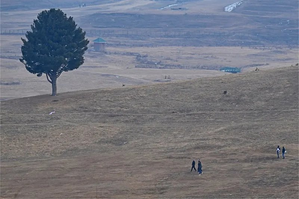Chillai Kalan sans snow sends shivers of worry across Kashmir valley
By Kavya Dubey
New Delhi/Srinagar, Jan 22 : Scores of people thronged Srinagar’s historic Jamia mosque praying for snow to touch the barren grounds of what would have been proudly proclaimed to be a “winter wonderland” in a normal winter season in Kashmir.
Chillai Kalan is the most inclement period in Kashmir that begins on the winter solstice (December 21) and ends with the month of January. These freezing days also bring with them the bounty for Kashmir’s water resources — the elixir that makes the valley a place of prosperous abundance.
“Sheen e peto peto, mama yito, yito” (O snow, come, fall soon, O Mama, visit us soon) is a popular saying, now oft-repeated with pining and anticipation across the valley, for it is rare for Chillai Kalan to go without snow for so long.
Kashmir cannot be Kashmir without winter snow. For Ghulam Mohamed Mir, who has seen in Kashmir through 80 winters of his life, this is a time to keep calm and look ahead in the hope for the best.
A resident of Shopian, Mir is an inspiringly healthy and active farmer engaged in growing a variety of vegetables and fruits, besides engaging in poultry farming, dairying and fishing.
Referring to the extended dry spell in Kashmir, Mir said: “I’ve seen it several times over in my lifetime. It will snow for sure during Chillai Bacha.” Chillai Bacha is the 10-day period that follows Chillai Kalan and following that is Chillai Khurd.
Although not as intense as Chillai Kalan, Chillain Bacha sees precipitation taking place normally. As of now, snowfall is predicted to happen only in the last week of January.
So, Mir believes that a dry Chillai Kalan, which is not happening for the first time, is not something to be intimidated by.
In the larger context of matter, though, this eccentric weather pattern is the effect of a bigger climate phenomenon.
Prof. Shakil Ahmad Romshoo, Vice-Chancellor, Islamic University of Science and Technology, Kashmir, explained to IANS: “El Nino-Southern Oscillation (ENSO) and North Atlantic Oscillation (NAO) anomalies exert strong control on the climate of the northern hemisphere. The weather in Jammu, Kashmir and Ladakh is primarily influenced by Western Disturbances, which originate from the Atlantic Ocean and the Mediterranean Sea.”
Romshoo continued: “Through our research, we have established a strong relationship between winter precipitation (snowfall) and NAO in the Kashmir region. Positive NAO results in more western disturbances and the winter storms (snowfall) that bring with them the majority of winter precipitation to the Kashmir region.
“However, we had a negative NAO during December 2023, and a strongly negative NAO is predicted for January 2024, which could easily be one of the top four most negative NAOs in the past 25 years leading to very low snowfall this winter.”
Precipitation during winter months (December to March) is vital for optimal agricultural yield in the Kashmir region, for the sake of biodiversity across the region, and for its food, water and energy security.
With the prevailing condition of prolonged dry spell, the difficulties that are already expected pertain to depleted groundwater and overall water scarcity during summers, which, in turn, will cause several other problems.
Dr Mukhtar Ahmed, Head of the Meteorological Centre, Srinagar, speaking to IANS, also said that the ongoing dry spell is not a first-time occurrence. He noted: “Such dry spells have occurred in January 2018, and that was true in December 2016, January 2015, December 2014, January 2007 and January 2003.” And added: “This is the strongest El Nino in the last 40-50 years.”
El Nino is primarily the warming phase of the sea temperature, which, depending on intensity, has an impact on global climate.
Dry spells are typically accompanied with increased temperatures, and this has its long-term and short-term impacts.
Ahmed explained that long-term impacts include shrinking of glaciers, increased temperatures, hampered water table replenishment and power generation; whereas the short-term impact is shown up on the affected harvest season in the compromised quality of fruit crops such as peach, cherry, apple, pear and plum.
Apple is a prized and lucrative crop synonymous with Kashmir, from where 78 per cent of India’s apples come every year. The fruit has been the cornerstone of Kashmir’s economy for a good 800 years.
Ubair Shah, a third-generation apple farmer in the valley, said that “apple orchards need a period of dormancy to get a good yield.” And snow is essential to this process.
“In spite of the relentless cold temperature, the absence of snow is a matter of concern,” he added.
“With snow, freezing temperatures [on the ground] remain till noon despite positive temperature in the daytime. So, the dormancy cycle of a tree is not disturbed. The situation now is 15 degrees [Celsius] in the day and minus 2 or 3 at night,” Shah explained, stating that this extreme variation in temperatures in the absence of a snow cover on soil disturbs the balance in the temperature required for the tree to be dormant.
Snow cover helps maintain the low temperature on the ground despite the days being warmer, and prevents the earth from heating up despite clear sunlight.
The ideal condition for a bumper apple harvest would be snowfall in January and February for ideal dormancy. March onwards, the weather gets warmer and the snow starts melting. “December to mid-February is the most critical time, weather-wise, for the apple trees,” Shah said.
In the apple harvest cycle, the tree’s dormancy ends around March and April is when it blossoms. Then the fruit grows and ripens enough to be plucked around its harvest time, which extends up till mid-August to October-end.
The expansive commerce surrounding the apple crop may not be severely impacted by an eccentric season or two so as to affect people’s livelihood, but the cultivation of water-intensive crop such as paddy will be difficult.
Experts believe that people will be forced to consider switching over to alternatives that require less water. Such a proposition, however, also necessitates a cultural and social change.
Romshoo, who also specialises in water resources engineering, explained: “The less than normal snowfall, together with abnormal above-average high day temperatures this winter, and the long dry period spanning autumn and winter, might lead to water shortages in the summer, which will not be sufficient to meet the requirements of water-intensive paddy cultivation.
“We therefore need to switch over to less water-intensive crops such as pulses, maize, millets, and so on. Comparatively, the water requirement of horticulture is less, so it may not get adversely affected.”
On the question of adequate awareness about the impact of unusual weather events in Kashmir and their effect on local communities, senior journalist and researcher Athar Parvaiz observed that “there is a disparity in media coverage of the current climate-driven drought’s impact on rural communities as well as the impact to be seen in Srinagar or other tourist places such as Gulmarg.”
Pervaiz pointed out: “In rural areas, communities are suffering on many fronts — from limited or non-availability of water and electricity to the worries about the upcoming cropping season as water scarcity looms because of the huge deficit in winter precipitation. In many areas of rural Kashmir, streams, the sources of water for rural communities, have partly or completely dried up.”
Concluded on a note of uncertainty mingled with hope, Pervaiz said: “There are stories about an ongoing drought in villages that need to be highlighted for the authorities to take note of.”



